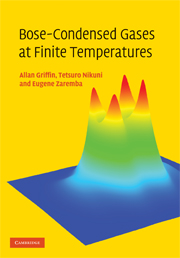Book contents
- Frontmatter
- Contents
- Preface
- 1 Overview and introduction
- 2 Condensate dynamics at T = 0
- 3 Coupled equations for the condensate and thermal cloud
- 4 Green's functions and self-energy approximations
- 5 The Beliaev and the time-dependent HFB approximations
- 6 Kadanoff–Baym derivation of the ZNG equations
- 7 Kinetic equation for Bogoliubov thermal excitations
- 8 Static thermal cloud approximation
- 9 Vortices and vortex lattices at finite temperatures
- 10 Dynamics at finite temperatures using the moment method
- 11 Numerical simulation of the ZNG equations
- 12 Simulation of collective modes at finite temperature
- 13 Landau damping in trapped Bose-condensed gases
- 14 Landau's theory of superfluidity
- 15 Two-fluid hydrodynamics in a dilute Bose gas
- 16 Variational formulation of the Landau two-fluid equations
- 17 The Landau–Khalatnikov two-fluid equations
- 18 Transport coefficients and relaxation times
- 19 General theory of damping of hydrodynamic modes
- Appendix A Monte Carlo calculation of collision rates
- Appendix B Evaluation of transport coefficients: technical details
- Appendix C Frequency-dependent transport coefficients
- Appendix D Derivation of hydrodynamic damping formula
- References
- Index
15 - Two-fluid hydrodynamics in a dilute Bose gas
Published online by Cambridge University Press: 06 October 2009
- Frontmatter
- Contents
- Preface
- 1 Overview and introduction
- 2 Condensate dynamics at T = 0
- 3 Coupled equations for the condensate and thermal cloud
- 4 Green's functions and self-energy approximations
- 5 The Beliaev and the time-dependent HFB approximations
- 6 Kadanoff–Baym derivation of the ZNG equations
- 7 Kinetic equation for Bogoliubov thermal excitations
- 8 Static thermal cloud approximation
- 9 Vortices and vortex lattices at finite temperatures
- 10 Dynamics at finite temperatures using the moment method
- 11 Numerical simulation of the ZNG equations
- 12 Simulation of collective modes at finite temperature
- 13 Landau damping in trapped Bose-condensed gases
- 14 Landau's theory of superfluidity
- 15 Two-fluid hydrodynamics in a dilute Bose gas
- 16 Variational formulation of the Landau two-fluid equations
- 17 The Landau–Khalatnikov two-fluid equations
- 18 Transport coefficients and relaxation times
- 19 General theory of damping of hydrodynamic modes
- Appendix A Monte Carlo calculation of collision rates
- Appendix B Evaluation of transport coefficients: technical details
- Appendix C Frequency-dependent transport coefficients
- Appendix D Derivation of hydrodynamic damping formula
- References
- Index
Summary
In Chapters 11–13, we gave a detailed discussion of the dynamics of a trapped Bose gas at finite temperatures in a region where the collisions described by the C12 and C22 terms in the kinetic equation (3.42) do not play the central role. In this “collisionless” region, the dominant interaction effects are associated with the self-consistent fields which both the condensate and noncondensate atoms feel. Thus the dynamics can be understood to a first approximation by neglecting the C12 and C22 collision integrals in the kinetic equation and, at the next stage, treating them as a weak perturbation on the collisionless dynamics.
In the rest of this book (Chapters 15–19), we turn to the study of the coupled ZNG equations in the opposite limit, where the C12 and C22 collision integrals completely determine the dynamics of the thermal cloud. Specifically, the collisions lead to the thermal cloud being in local hydrodynamic equilibrium, and hence this regime is described by the equations of collisional hydrodynamics. Its characteristic feature is that the nonequilibrium behaviour of the thermal cloud atoms can be completely described in terms of a few differential equations involving coarse-grained variables that are dependent on position and time, analogous to the condensate variables nc(r, t) and vc(r, t). In the present chapter, assuming that the thermal cloud distribution function f(p, r, t) is given by the Bose distribution describing partial local equilibrium, (15.16), we show how the ZNG coupled equations lead precisely to Landau's two-fluid equations, reviewed in Chapter 14. This equivalence is not obvious, mainly because Landau's equations are expressed in terms of thermodynamic variables, which are not used in a more microscopic analysis such as that used in the ZNG approach.
- Type
- Chapter
- Information
- Bose-Condensed Gases at Finite Temperatures , pp. 322 - 348Publisher: Cambridge University PressPrint publication year: 2009



